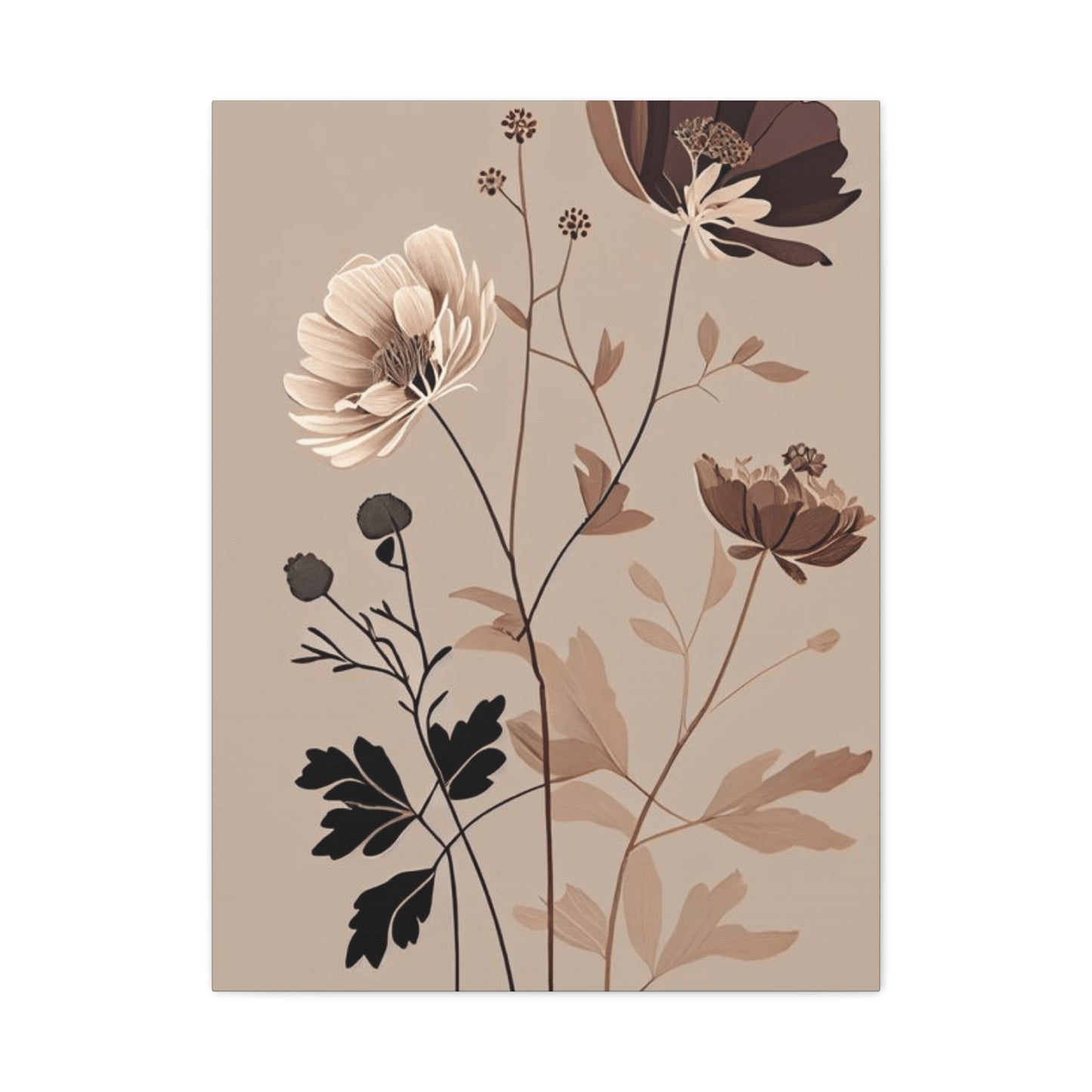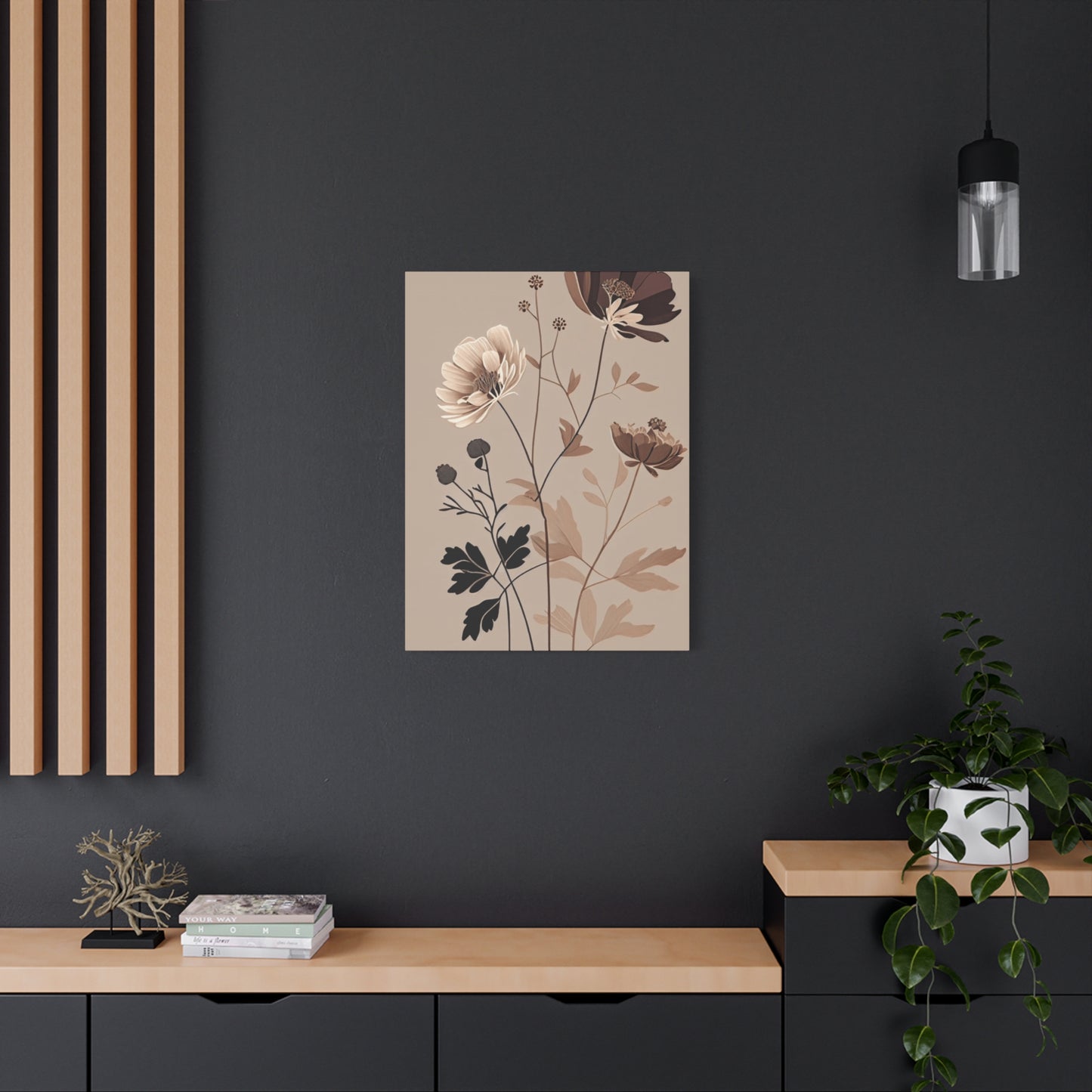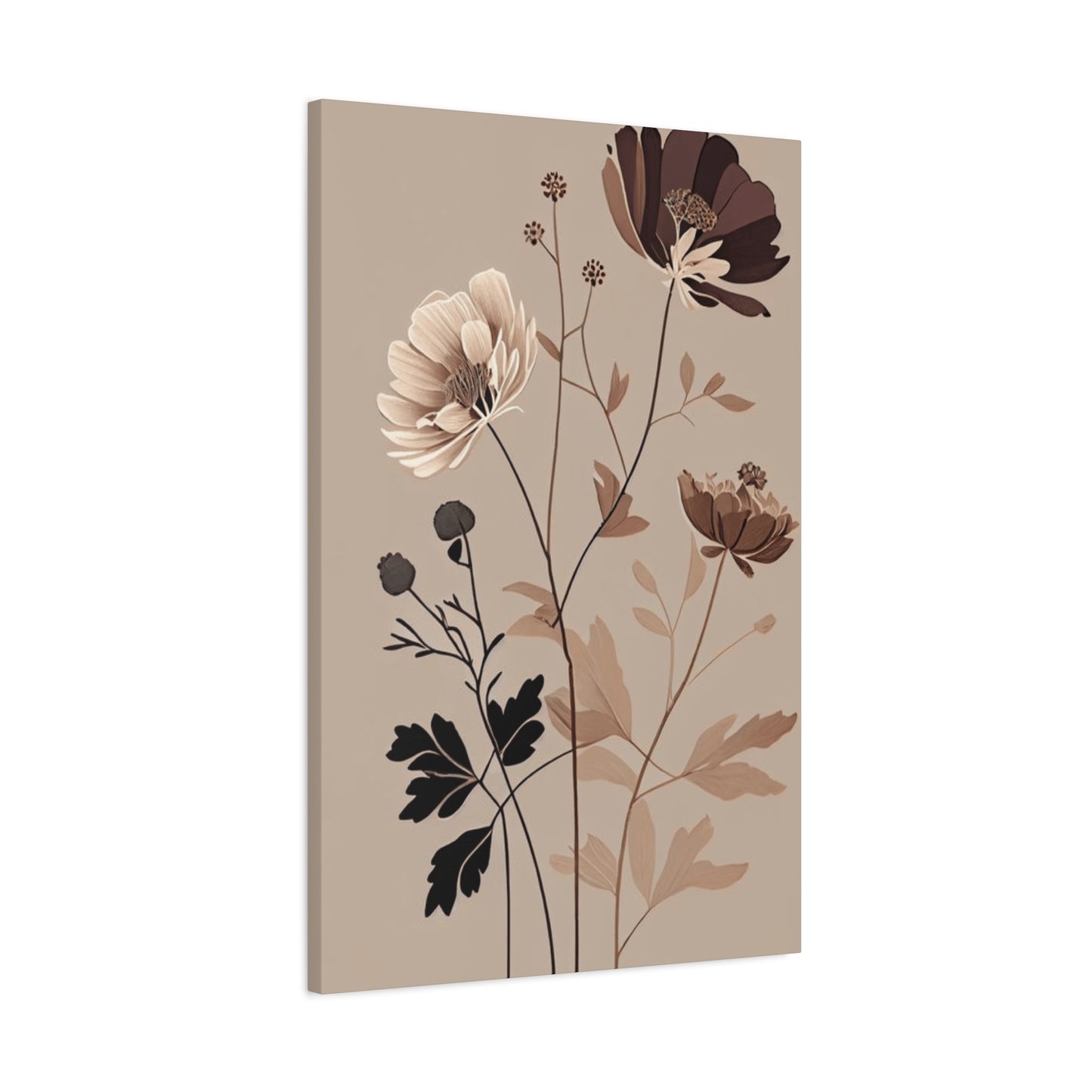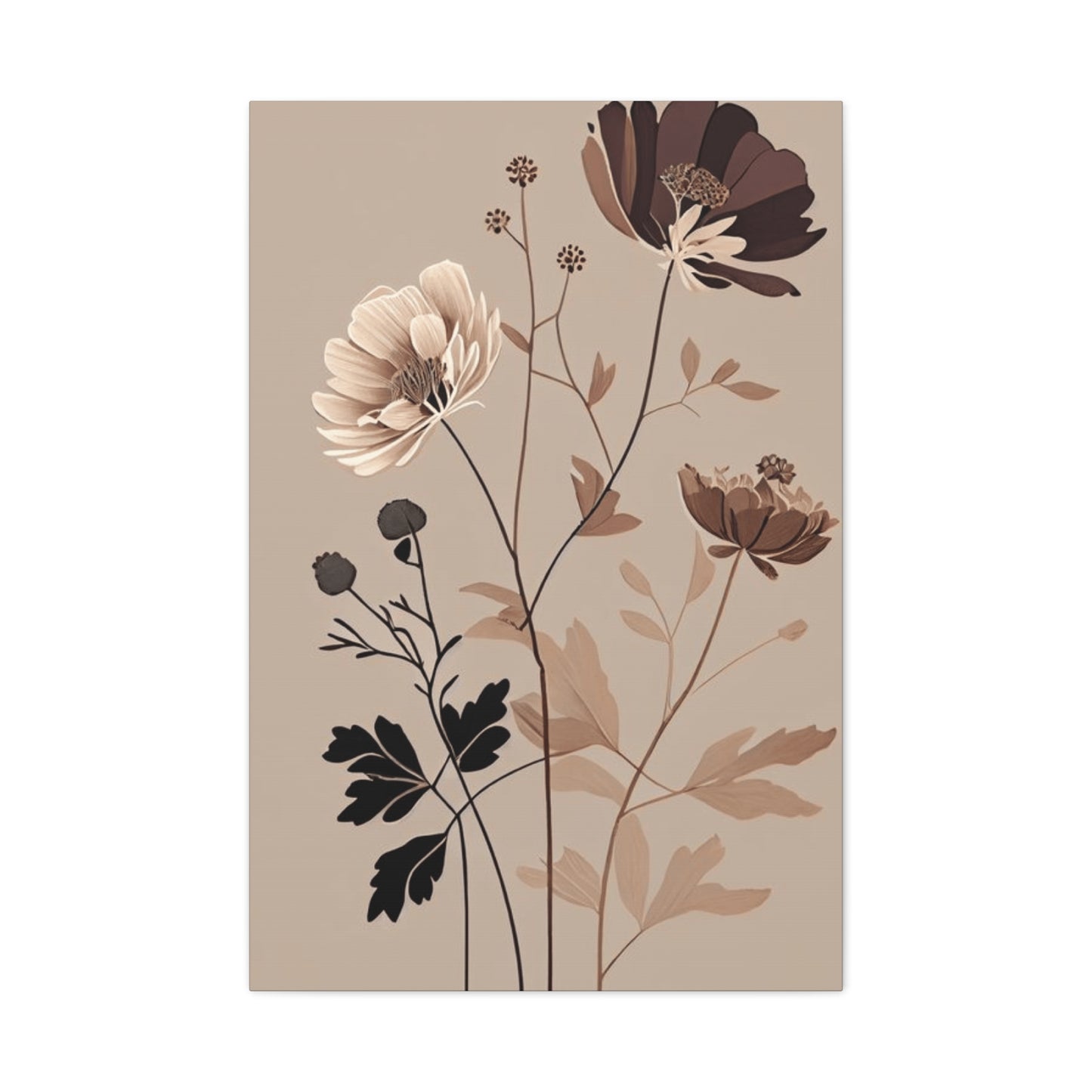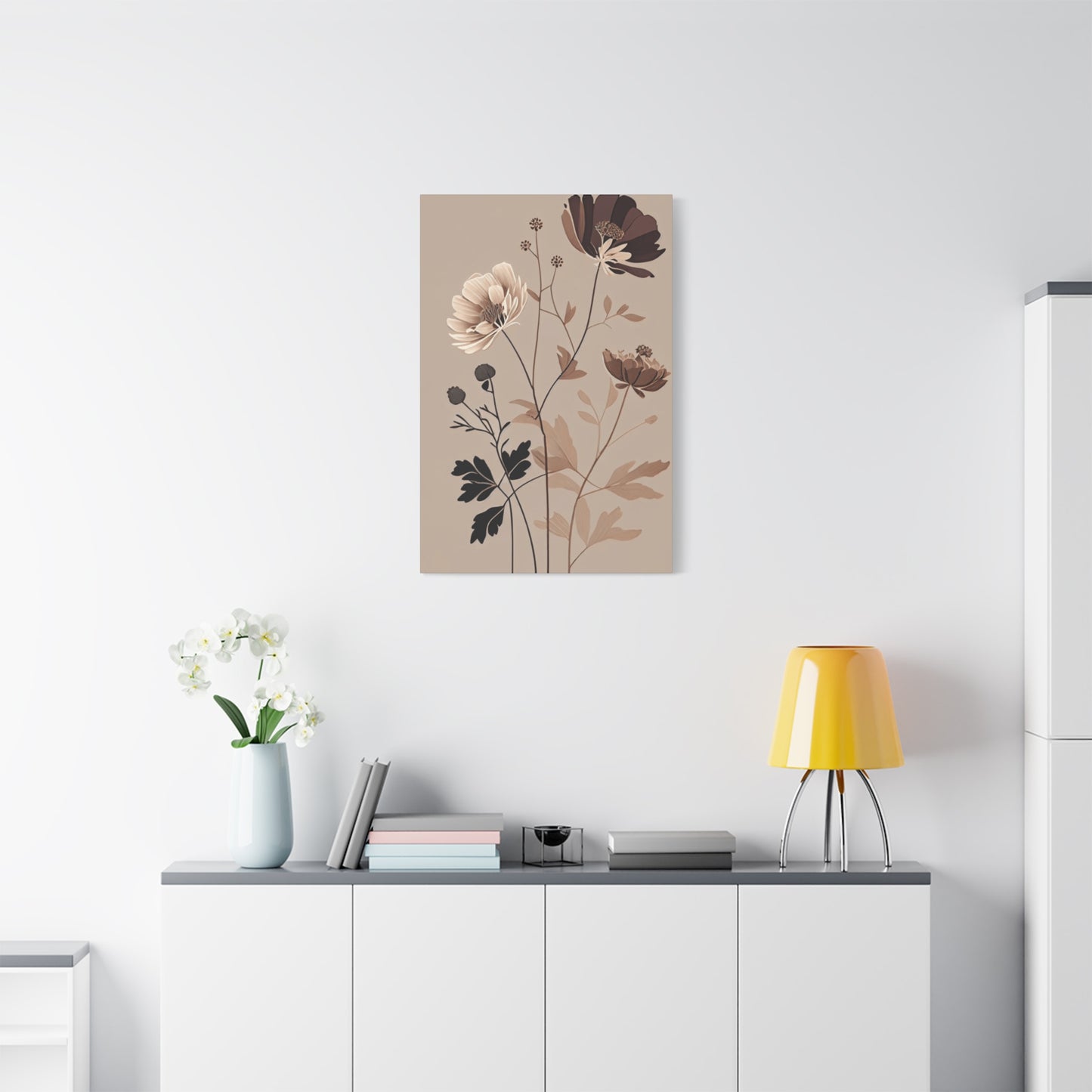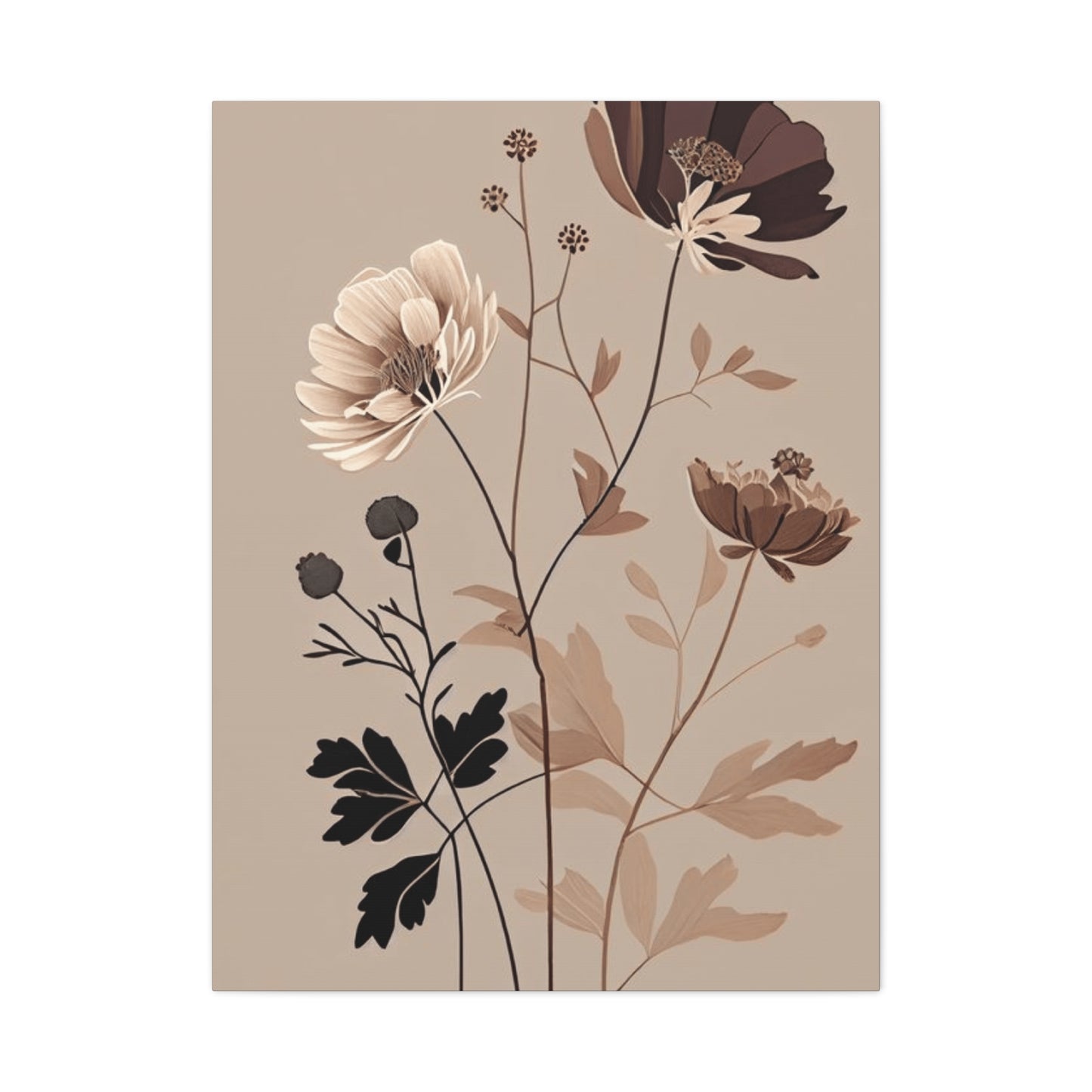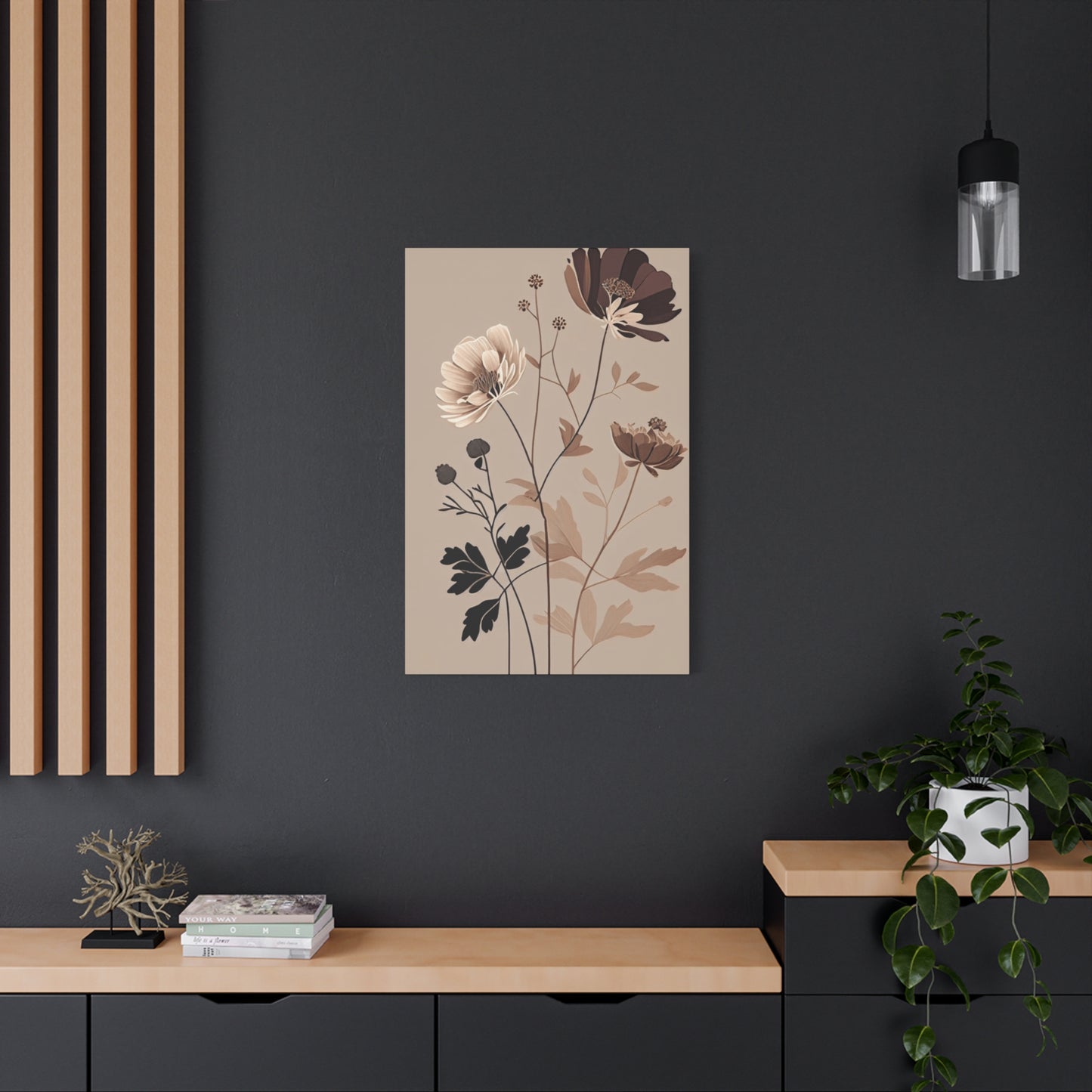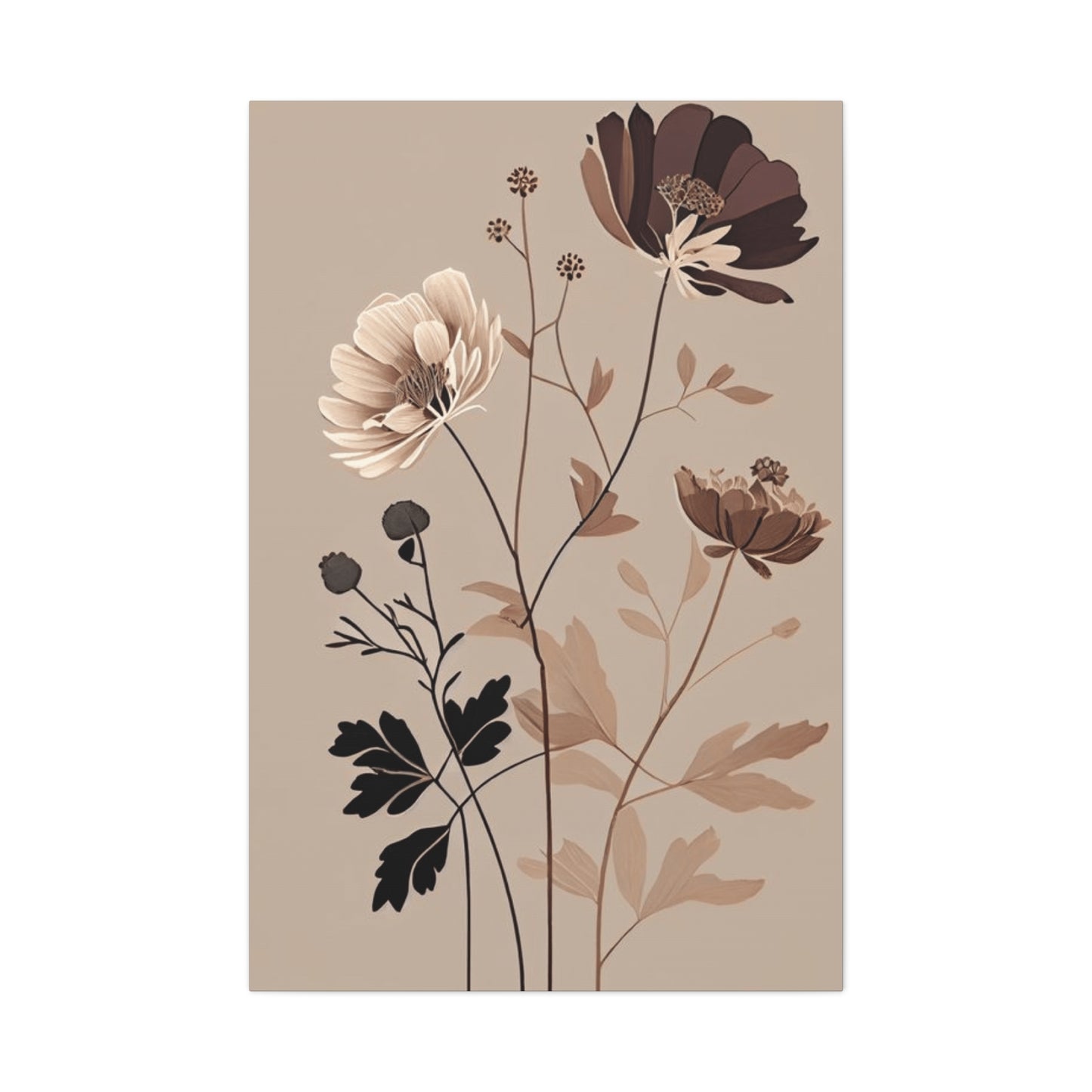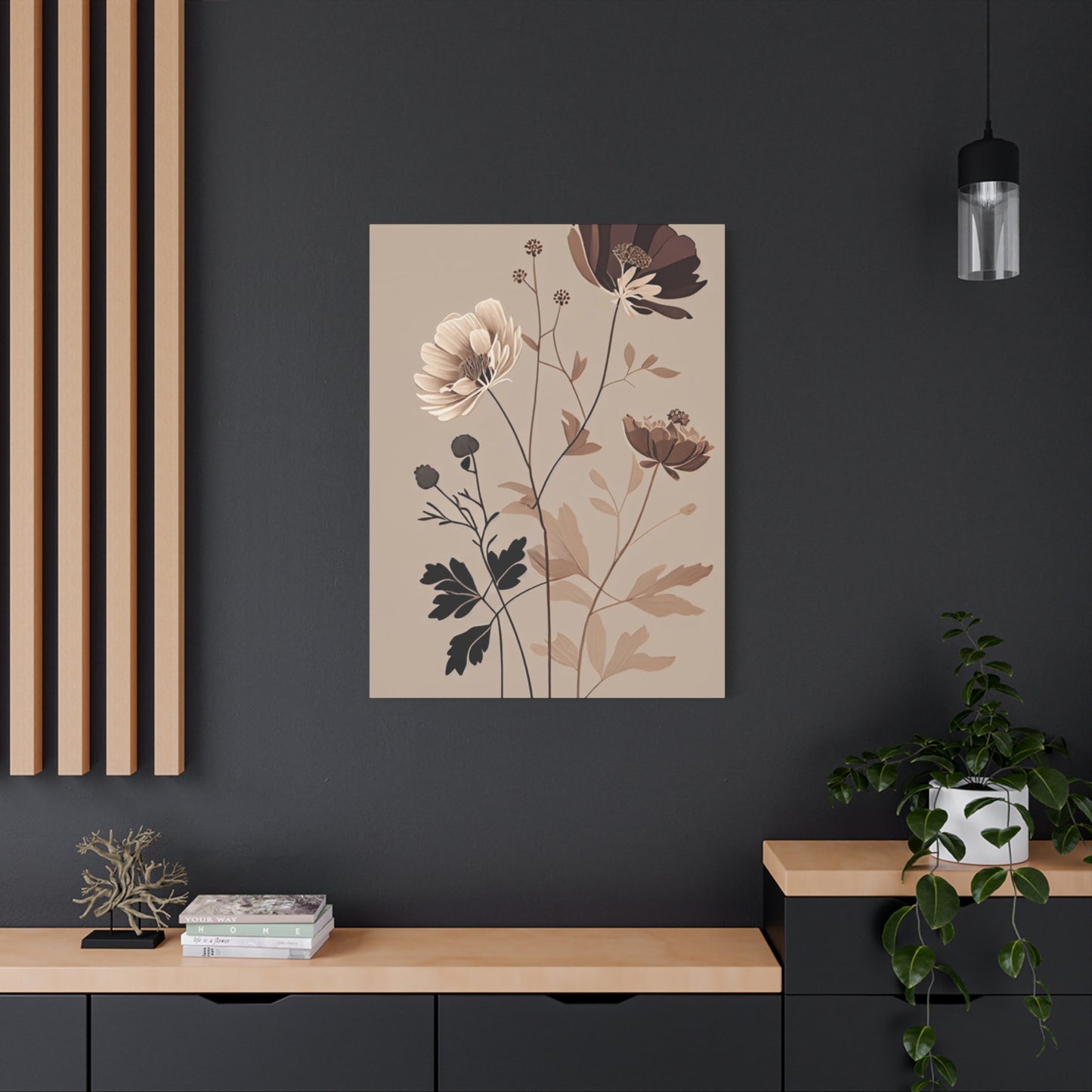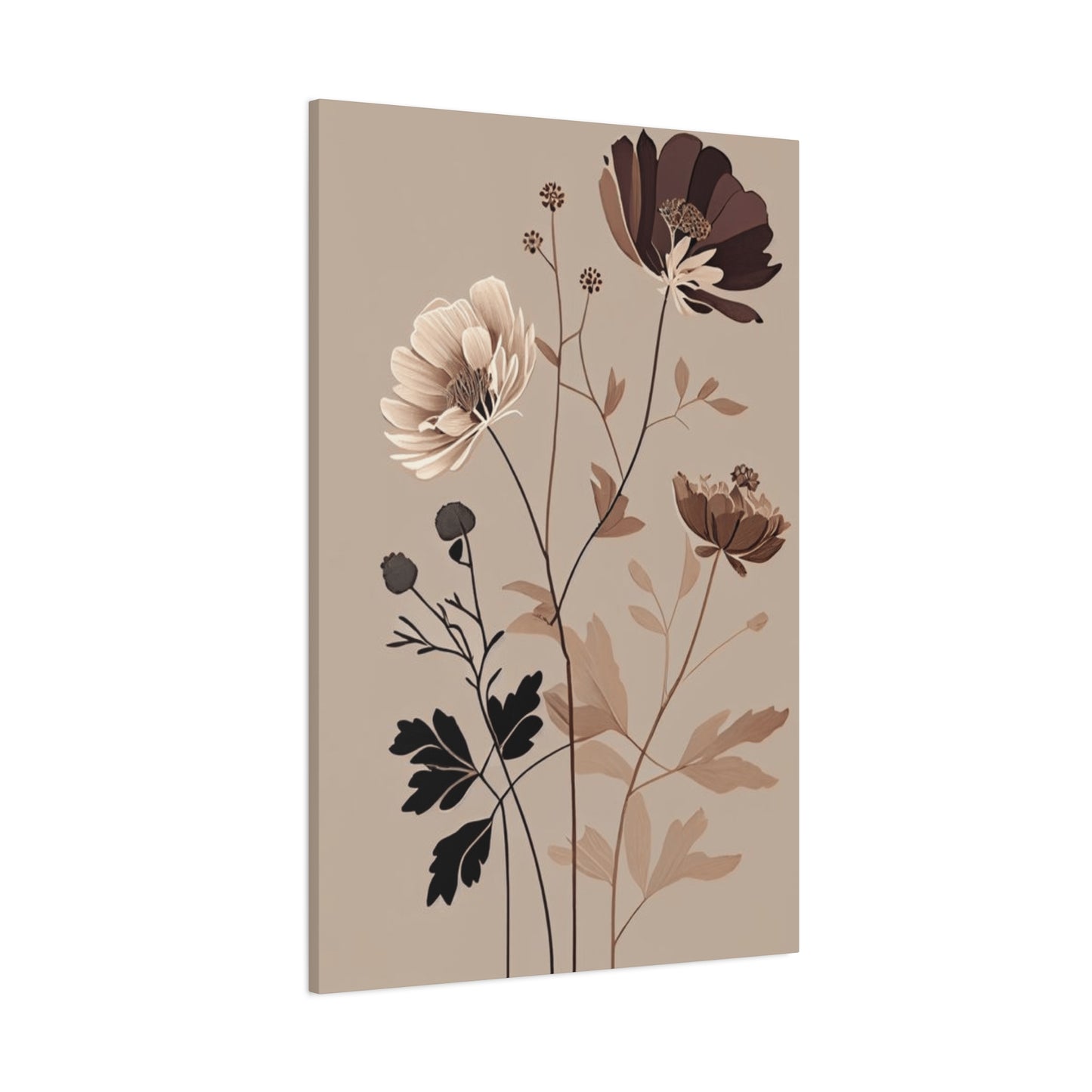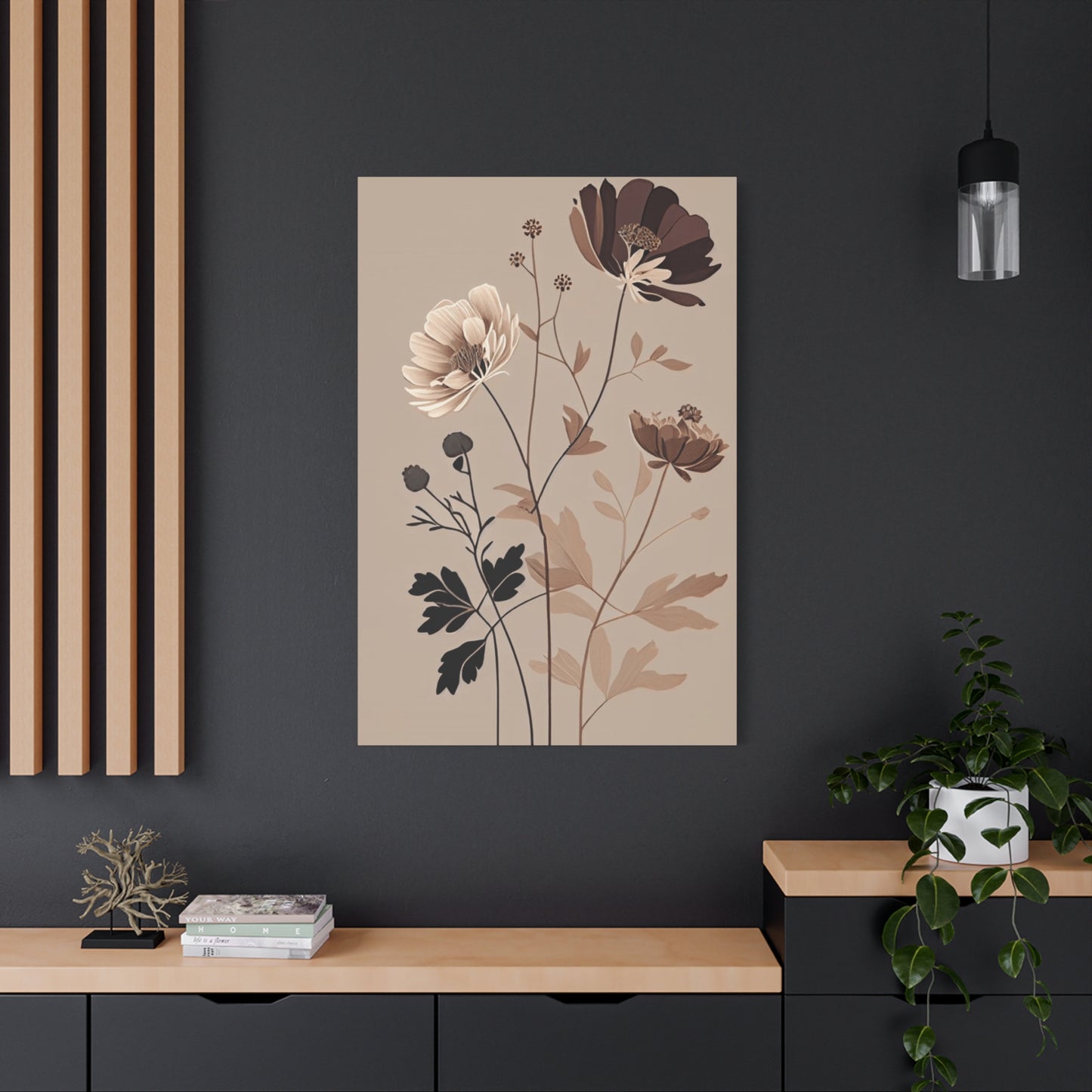Nature’s Palette: How Artistic Floral Wall Art Captures the Beauty of the Outdoors
The world of interior design has witnessed a remarkable resurgence in the appreciation of nature-inspired artwork, particularly hand-painted botanical compositions that bring the outdoors inside. These magnificent pieces serve as more than mere decorative elements; they represent a harmonious blend of artistic expression and natural beauty that transforms ordinary rooms into extraordinary sanctuaries. The growing demand for such artwork reflects our innate desire to reconnect with nature, especially in urban environments where green spaces are increasingly scarce. When we examine the appeal of these creations, we discover layers of meaning that extend far beyond their visual impact, touching upon our emotional wellbeing, cultural heritage, and personal identity.
Botanical artwork has evolved from simple botanical illustrations used for scientific purposes to sophisticated artistic expressions that capture the essence of plant life in all its glory. The journey from pressed flowers and watercolor sketches to large-scale canvas paintings represents centuries of artistic innovation and changing aesthetic preferences. Today's collectors and homeowners seek pieces that not only beautify their spaces but also convey stories, evoke emotions, and reflect personal values. The market for such artwork has expanded dramatically, with artists employing various techniques, from traditional oil painting methods to contemporary mixed-media approaches that incorporate texture, metallic accents, and unconventional materials.
The Rich Heritage Behind Botanical Artwork in Human Culture
Throughout human history, plants have held profound significance in virtually every culture, serving as symbols of life, growth, fertility, and renewal. Ancient civilizations documented plant life not only for medicinal and agricultural purposes but also as expressions of beauty and spiritual connection. Egyptian tomb paintings featured elaborate garden scenes with carefully rendered lotus flowers, papyrus plants, and date palms, demonstrating the importance of botanical imagery in their conception of the afterlife. Similarly, Chinese artists have practiced the art of flower and bird painting for over a thousand years, developing sophisticated techniques that capture not just the physical appearance of plants but their essential spirit or life force.
The European Renaissance brought botanical illustration to new heights as explorers returned from distant lands with specimens of exotic plants never before seen on the continent. Artists and scientists collaborated to create detailed records of these discoveries, producing works that were simultaneously scientifically accurate and aesthetically pleasing. The tradition of botanical art reached its zenith in the eighteenth and nineteenth centuries, with artists like Pierre-Joseph Redouté creating masterpieces that remain influential today. His roses, rendered with extraordinary delicacy and precision, set standards that contemporary artists still aspire to achieve.
In Japan, the appreciation of seasonal flowers became deeply embedded in cultural practices through ikebana, the art of flower arrangement, and through painting traditions that celebrated cherry blossoms, chrysanthemums, and morning glories. These artistic traditions emphasized simplicity, asymmetry, and the beauty of imperfection, philosophies that continue to influence contemporary botanical artwork. The Japanese aesthetic principle of wabi-sabi, which finds beauty in impermanence and imperfection, offers a counterpoint to Western traditions of botanical illustration that often sought perfect specimens and idealized representations.
Indigenous cultures worldwide have incorporated plant imagery into their artistic traditions, often imbuing specific flowers and plants with spiritual significance. Native American artists used botanical motifs in beadwork, pottery, and textile designs, each plant carrying specific meanings and stories passed down through generations. Australian Aboriginal art frequently features native plants like wattle and eucalyptus, connecting artistic expression with country and ancestral knowledge. These diverse cultural traditions remind us that botanical artwork serves purposes beyond decoration, functioning as a means of preserving knowledge, expressing identity, and maintaining connections with the natural world.
Contemporary Artistic Approaches to Creating Nature-Inspired Canvas Works
Modern artists working with botanical themes employ an impressive range of techniques and styles, from photorealistic representations to abstract interpretations that capture the essence rather than the exact appearance of plant forms. Some artists work in the classical tradition, using oil paints to build up layers of color and detail that create luminous, lifelike images. These works often require months of careful observation and meticulous application of paint, resulting in pieces that rival the finest botanical illustrations of previous centuries. The slow, meditative process of creating such work appeals to artists seeking refuge from our fast-paced digital world, and collectors appreciate the dedication and skill evident in every brushstroke.
Other contemporary artists take more experimental approaches, incorporating mixed media elements that add texture and dimension to their compositions. They might combine acrylic paints with gold leaf, creating areas of shimmering luminosity that suggest morning dew or the play of sunlight on petals. Some apply thick impasto techniques, building up paint in sculptural forms that make flowers seem to emerge from the canvas surface. Others incorporate collage elements, pressing actual dried flowers and leaves into their paintings or layering translucent papers to create depth and complexity. These innovative techniques reflect contemporary art's emphasis on experimentation and the breakdown of traditional boundaries between different artistic media.
Abstract interpretations of botanical forms have gained considerable popularity in recent years, particularly among collectors seeking artwork that complements minimalist or contemporary interior design schemes. These pieces might reduce plant forms to their essential shapes and colors, creating compositions that suggest rather than literally depict flowers, leaves, and stems. Some artists work with large gestural brushstrokes that capture the energy and movement of plants swaying in wind or reaching toward light. Others employ carefully controlled color fields that evoke the emotional qualities associated with different plants and seasons without attempting representational accuracy.
Transformative Effects on Interior Environments and Personal Spaces
The presence of botanical artwork in living spaces creates profound effects on atmosphere, mood, and the overall experience of inhabiting a room. Large-scale canvas paintings featuring lush flowers or verdant foliage can serve as focal points that anchor entire rooms, providing visual interest and establishing color palettes that influence all other design decisions. A single impressive piece positioned above a sofa or fireplace can eliminate the need for multiple smaller decorative elements, creating a sense of sophisticated simplicity. The scale of such works commands attention without overwhelming, especially when the subject matter connects viewers to the calming, restorative qualities of nature.
Color psychology plays a significant role in how botanical artwork affects our experience of interior spaces. Paintings featuring cool blues and greens evoke tranquility and promote relaxation, making them ideal for bedrooms and meditation spaces. Warm oranges, reds, and yellows create energizing, welcoming atmospheres suited to social spaces like living rooms and dining areas. Soft pinks and lavenders introduce romantic, gentle qualities perfect for personal sanctuaries. Understanding these psychological effects allows homeowners to select artwork that not only appeals aesthetically but also supports the intended function and feeling of each room.
The placement of botanical artwork requires consideration of both practical and aesthetic factors. Natural and artificial lighting significantly affect how colors appear and how details read from various distances. Paintings placed opposite windows may suffer from glare at certain times of day, while those in darker corners might require supplementary lighting to reveal their full beauty. The viewing distance also matters; highly detailed works reward close examination but should also read clearly from across the room. Height placement follows general guidelines but should account for furniture arrangements and sight lines from different positions within the space.
Botanical artwork can bridge different design styles, making it remarkably versatile for varied interior aesthetics. In traditional settings, classical botanical paintings in ornate gilded frames enhance the elegant, refined atmosphere while providing connections to historical artistic traditions. Contemporary spaces benefit from bold, oversized canvases with simplified botanical forms or abstract interpretations that complement clean lines and minimalist furnishings. Transitional interiors that blend traditional and modern elements can incorporate botanical artwork that similarly balances classical subject matter with contemporary execution or presentation. Even industrial-style spaces gain softness and warmth from the introduction of botanical imagery, with the natural forms providing pleasant contrast to exposed brick, metal, and concrete surfaces.
Selecting Appropriate Botanical Artwork for Different Room Functions
Each room in a home serves distinct purposes and evokes different moods, requiring thoughtful consideration when selecting botanical artwork. Living rooms, as primary social and family gathering spaces, benefit from artwork that creates welcoming, engaging atmospheres. Bold, colorful botanical pieces featuring abundant blooms or lush garden scenes contribute to a sense of vitality and warmth. These spaces can accommodate larger scale works that make strong visual statements without overwhelming, especially when positioned above major furniture pieces like sofas or console tables. The artwork selected for living areas should invite conversation and create positive impressions for visitors while reflecting the personal style and interests of residents.
Bedrooms demand more careful consideration, as these intimate spaces require artwork that promotes relaxation and restful sleep. Softer color palettes featuring pale blues, lavenders, greens, and neutrals create soothing atmospheres conducive to unwinding. Botanical subjects might include delicate wildflowers, peaceful garden scenes, or simplified compositions with minimal detail that don't overstimulate the mind. The emotional quality of bedroom artwork matters more than dramatic visual impact; these pieces should feel like gentle companions that ease the transition from waking activity to restful sleep. Some people find that familiar flowers associated with positive memories or meaningful symbolism enhance the personal sanctuary quality of their bedroom.
Dining rooms offer opportunities for more dramatic or sophisticated botanical artwork selections. These spaces, designed for gatherings and celebrations, can accommodate richer colors, more elaborate compositions, and artwork with stronger presence. Still life paintings featuring flowers arranged with fruit, wine, or other elements connect to traditional themes of abundance and hospitality. The artwork scale should relate appropriately to the dining table and surrounding furniture, neither disappearing against the wall nor dominating so completely that it becomes distracting during meals. Lighting in dining areas, often featuring dimmer controls for ambiance variation, should be considered to ensure artwork remains visible and appealing under different conditions.
Home offices and study spaces benefit from botanical artwork that inspires creativity and focus without creating distraction. Clean, simple compositions with limited color palettes often work well in these environments, providing visual interest during brief mental breaks while maintaining a professional atmosphere. Small to medium scale works placed at eye level when seated at a desk offer pleasant focal points for moments of contemplation. Plants associated with knowledge, growth, or perseverance might carry particular meaning in work environments, serving as subtle motivational elements.
Kitchens and casual eating areas can incorporate more playful or informal botanical artwork that celebrates food cultivation and the pleasures of cooking. Herb gardens, vegetable plants, or fruit-bearing trees make thematically appropriate subjects. These spaces often feature warm, active lighting that shows colors vibrantly, supporting artwork with saturated hues. Practical considerations include selecting pieces that can withstand the moisture and temperature fluctuations typical of kitchen environments, potentially choosing canvas prints or protected originals rather than more delicate works on paper.
The Process of Creating Hand-Painted Botanical Canvas Art
Understanding the artistic process behind botanical canvas paintings deepens appreciation for these works and helps collectors recognize quality and value. The journey begins with inspiration and conceptualization, as artists consider which plants to feature, what compositional arrangements will be most effective, and what emotional qualities they wish to convey. Some artists work primarily from life, setting up fresh flower arrangements in their studios and painting from direct observation. This approach captures the authentic colors, textures, and three-dimensional forms of actual plants, resulting in works with immediate, tangible connections to living nature.
Others rely primarily on photographic references, which offer advantages including the ability to work with seasonal plants year-round, to combine elements from multiple sources into idealized compositions, and to capture fleeting moments like flowers at peak bloom or morning dew before it evaporates. Contemporary technology enables artists to take hundreds of reference photos from different angles and in varied lighting, creating comprehensive visual libraries that inform their work. Some artists combine observation and photography, using photos for initial sketching and composition but painting final details from life to capture subtleties that cameras miss.
The preparation of canvas represents a crucial stage that affects every subsequent step of the painting process. Artists typically begin with pre-stretched canvas or stretch their own over wooden frames, ensuring the fabric is taut but not so tight that it might tear or warp. Applying sizing prevents paint from being absorbed too quickly into the canvas fibers, and priming with gesso creates a smooth, receptive surface for paint application. Some artists apply multiple gesso coats, sanding between applications to achieve perfectly smooth surfaces ideal for detailed work. Others prefer more textured grounds that contribute to the final painting's visual character.
Preliminary sketching establishes the composition, working out the placement of major elements and the overall design before committing to paint application. Some artists draw directly on the primed canvas with pencil or charcoal, while others develop detailed preparatory drawings on paper that they then transfer to canvas using grid methods or projection. This planning stage allows experimentation with different arrangements, the adjustment of proportions, and the resolution of compositional problems before valuable paint is applied. Classical artists often created highly finished preparatory drawings that served as complete blueprints for their paintings, while more intuitive painters might sketch only basic placements, allowing spontaneity during the painting process.
The underpainting establishes the value structure and sometimes preliminary color relationships that will guide all subsequent paint layers. Some artists work in monochrome, establishing the full range of lights and darks before introducing color. Others apply thin washes of color that set the overall temperature and mood while remaining transparent enough that later layers can modify them. The underpainting typically employs lean paint with minimal oil content, following the fat-over-lean principle that helps ensure proper drying and prevents cracking. This foundation stage, though ultimately invisible, profoundly affects the final painting's luminosity, depth, and overall success.
Preservation and Care for Botanical Canvas Artwork
Proper care ensures that botanical canvas paintings retain their beauty and value for generations, making preservation knowledge essential for collectors and homeowners. Environmental conditions significantly impact artwork longevity, with temperature and humidity fluctuations presenting the greatest threats. Canvas expands and contracts in response to moisture changes, creating stress that can lead to cracking of paint layers or even canvas tears. Maintaining relatively stable conditions, ideally between sixty and seventy degrees Fahrenheit with relative humidity between forty and fifty-five percent, helps prevent these problems. In regions with extreme seasonal variations, using humidifiers in winter and dehumidifiers in summer can protect valuable artwork.
Light exposure, particularly ultraviolet radiation, causes irreversible damage to paintings over time, fading colors and degrading materials. Direct sunlight represents the most serious threat, with even brief regular exposure capable of causing noticeable fading within months. Window treatments like UV-filtering films, shades, or curtains should protect artwork from direct sun exposure, and even indirect natural light merits consideration for highly valuable pieces. Artificial lighting presents fewer risks but should still be monitored, particularly halogen bulbs that emit more UV radiation than LED alternatives. Museums and serious collectors often use conservation framing with UV-protective glazing, and though canvas paintings are not glazed, applying UV-protective varnish provides some defense.
Regular dusting prevents the accumulation of particles that can abrade paint surfaces or attract moisture that supports mold growth. Using soft, clean brushes designed for artwork care or microfiber cloths allows gentle removal of surface dust without touching the paint directly. The dusting motion should be light and follow the direction of the canvas weave rather than scrubbing or wiping vigorously. For textured paintings with heavy impasto, extra care prevents catching raised paint areas that might be fragile. Dusting frequency depends on the environment, but monthly attention typically suffices for homes without unusual dust sources.
Varnishing protects paintings from dust, moisture, and minor abrasions while enhancing color depth and providing a uniform surface sheen. Some artists apply final varnish as part of their creative process, while others prefer that collectors make this decision based on personal preference and display conditions. Varnish should not be applied until paintings are thoroughly dry, which for oil paintings may require six months to a year. The type of varnish matters, with removable options allowing future cleaning and restoration work. Applying varnish requires skill to avoid drips, brush marks, or uneven coverage, leading many collectors to employ professional conservators for this service.
When cleaning becomes necessary beyond simple dusting, extreme caution is essential to avoid damaging artwork. Home cleaning should generally be limited to the gentlest methods, using distilled water lightly applied with soft cotton swabs to remove specific small spots of surface dirt from varnished paintings. Any more aggressive cleaning risks removing paint along with dirt, particularly if the painting lacks protective varnish or if the varnish has degraded. Professional conservators possess the expertise to safely clean paintings using appropriate solvents and techniques, making their services worthwhile for valuable works requiring more than surface dusting.
Proper hanging methods prevent physical damage while ensuring secure display. Artwork should hang from two points rather than one to distribute weight evenly and prevent tilting. D-rings attached to the frame or stretcher bars on each side, connected by picture wire, create secure hanging systems. The wire should be strong enough to hold several times the painting's weight, accounting for dynamic forces created by accidental bumps or seismic activity in earthquake-prone regions. Wall anchors appropriate to the wall type and artwork weight prevent failures that could damage paintings in falls. Positioning artwork away from heating vents, air conditioners, and fireplaces protects against rapid temperature and humidity changes.
The Investment Value and Collectibility of Botanical Canvas Works
Understanding botanical artwork as an investment category requires examining multiple factors that influence value, from artistic quality and provenance to market trends and condition. Original paintings by recognized artists can appreciate significantly over time, particularly works by artists who develop strong reputations or whose output is limited by death or retirement. The botanical genre has sustained popularity across centuries, suggesting ongoing demand rather than fleeting fashion, though specific styles within the genre rise and fall in favor. Collectors approaching purchases partially as investments should educate themselves about market dynamics, seek expert advice, and acquire works that appeal personally regardless of potential appreciation.
Artist reputation significantly impacts artwork value, with established names commanding premium prices while emerging artists offer more affordable entry points with appreciation potential. Researching an artist's exhibition history, educational background, awards and recognition, and previous sales helps assess their current and potential future market position. Artists with gallery representation, museum exhibitions, and favorable critical reviews typically maintain stronger markets than those without such professional validation. However, artistic quality does not always correlate with market success, and some exceptional artists work outside mainstream art world structures while others with significant reputations produce uneven work.
Provenance, the documented history of an artwork's ownership and exhibition, affects both authenticity confidence and market value. Works with clear provenance tracing back to the artist or reputable galleries face fewer authentication questions. Exhibition history at respected institutions enhances perceived importance and often value. Previous ownership by prominent collectors can increase prestige, particularly in cases where collections become known for quality or focus. Contemporary purchases directly from artists or established galleries create clear provenance, while secondary market acquisitions benefit from documentation including bills of sale, exhibition labels, and any correspondence with previous owners or the artist.
Condition profoundly affects artwork value, with pristine examples commanding premiums over damaged or poorly restored works. Examining paintings carefully before purchase reveals problems like cracking, flaking, discoloration, water damage, old repairs, or structural issues with stretchers or canvas. Some condition issues represent normal aging and present minimal concern, while others may require expensive conservation or permanently diminish value. Learning to recognize condition problems or working with advisors who possess this expertise protects collectors from purchasing damaged works at prices appropriate for pristine examples. Conservation reports from qualified professionals can clarify condition status for significant acquisitions.
Size influences both aesthetic impact and market value, with very large canvases generally commanding higher prices than smaller works by the same artist, assuming similar quality. Monumentally scaled paintings create dramatic presence but present challenges for collectors with limited wall space, potentially limiting their market. Conversely, very small works, though charming and affordable, may not provide sufficient visual impact for collectors seeking statement pieces. Mid-range sizes, typically from two to four feet in one or both dimensions, often represent the sweet spot for residential collectors, offering significant presence without overwhelming domestic spaces.
Contemporary Artists Excelling in Botanical Canvas Painting
The current generation of botanical artists demonstrates remarkable diversity in approach, technique, and aesthetic vision, with talented individuals working worldwide and sharing their art through galleries, exhibitions, and increasingly through social media and online platforms. These artists honor traditional botanical painting while incorporating contemporary perspectives, materials, and concerns. Some focus on endangered or threatened plant species, using their art to raise environmental awareness. Others explore the intersections of botanical subjects with abstract expressionism, bringing gestural energy to organic forms. Still others create hyperrealistic paintings that rival photography in detail while maintaining the warmth and soul of hand-created work.
Emerging artists often leverage social media to build audiences and sell work directly to collectors, bypassing traditional gallery systems that historically controlled access to art markets. Platforms focused on visual content allow artists to share works-in-progress, offering followers glimpses into creative processes while building anticipation for completed pieces. This direct connection with audiences creates communities of supporters who feel personally invested in artists' success. Some painters have built substantial followings numbering in the hundreds of thousands, translating social media presence into thriving businesses selling original works, prints, and licensed products. This democratization of art markets creates opportunities for talented artists who might previously have struggled to gain gallery representation.
Regional distinctions in botanical painting styles reflect both available flora and cultural aesthetic traditions. Artists working in tropical regions often paint the lush, vibrant flowers and foliage surrounding them, creating works that explode with color and vitality. Those in temperate zones might focus on seasonal progressions, from spring bulbs through summer abundance to autumn fruits and winter structures. Desert-dwelling artists find beauty in cacti, succulents, and the specialized adaptations that allow plants to survive in harsh environments. These regional differences provide collectors opportunities to acquire work reflecting specific places while supporting artists maintaining traditions rooted in particular locations.
Gender dynamics in botanical art present interesting patterns, with the field having historically attracted and embraced women artists more readily than many other art genres. Perhaps because flowers and plants were considered appropriate subjects for women during periods when academic figure painting remained largely closed to them, exceptional female botanical artists emerged and gained recognition even in restrictive eras. This tradition continues today, with many prominent botanical artists identifying as women, though the field welcomes artists of all genders. The historical association of botanical painting with femininity has sometimes resulted in the genre being taken less seriously than subjects coded as masculine, a bias that contemporary critics and curators increasingly challenge.
Training paths for botanical artists vary considerably, from formal fine arts education through specialized botanical illustration programs to self-directed study and practice. Traditional art school provides grounding in fundamental skills like drawing, color theory, and composition while exposing students to art history and critical thinking about their practice. Specialized botanical programs focus specifically on accurate plant representation, scientific illustration, and the particular technical demands of botanical subjects. Many successful botanical artists are essentially self-taught, developing skills through practice, studying masterworks, and experimenting with techniques. The field welcomes diverse backgrounds, with some artists coming to botanical painting after careers in other areas, bringing fresh perspectives and life experience to their work.
Creating Personal Connections Through Botanical Subject Selection
The specific flowers, plants, and compositions chosen for artwork can carry profound personal meaning, transforming decorative objects into repositories of memory, identity, and aspiration. Selecting botanical artwork that resonates personally creates deeper, more lasting satisfaction than choosing pieces based solely on aesthetic appeal or design coordination. Some people seek out representations of flowers associated with significant life events: the blooms carried in wedding bouquets, varieties grown in childhood gardens by beloved family members, or flowers native to meaningful locations. These personal associations transform artwork into treasured possessions that tell stories and maintain connections across time and distance.
Birth month flowers offer one framework for personal connection, with each month associated with particular blooms carrying symbolic meanings. January carnations represent admiration and love, while February violets signify faithfulness. March daffodils herald spring and new beginnings, and April daisies embody innocence and loyal love. May features lily of the valley and hawthorn, June showcases roses and honeysuckle, and July highlights larkspur and water lily. August brings gladiolus and poppy, September asters and morning glory, October marigolds and cosmos, November chrysanthemums, and December narcissus and holly. Displaying artwork featuring one's birth flower creates personal significance while providing an elegant response to visitors who inquire about the choice.
Cultural and familial heritage influences plant significance, with certain flowers carrying particular meanings in specific traditions. Cherry blossoms hold profound importance in Japanese culture, representing the beautiful but temporary nature of life. Lotus flowers occupy central positions in Hindu and Buddhist traditions, symbolizing spiritual enlightenment and the soul's journey from mud to flowering. Mexican marigolds play essential roles in Day of the Dead celebrations, guiding deceased loved ones home. Roses carry complex and varied symbolism across many cultures, from romantic love to political movements. Learning about cultural associations enriches appreciation of botanical artwork while potentially connecting contemporary collectors with ancestral traditions.
Symbolic meanings assigned to different flowers provide another layer of personal connection and expression. The Victorian language of flowers, in which entire messages could be conveyed through flower selections and arrangements, continues to fascinate contemporary audiences. Red roses universally symbolize passionate love, while white roses suggest purity and new beginnings. Sunflowers represent adoration and loyalty, and forget-me-nots make their meaning explicit in their name. Peonies symbolize romance, prosperity, and honor, making them popular wedding flowers. Lavender indicates devotion and virtue, while orchids suggest rare beauty and luxury. Selecting artwork featuring flowers whose symbolism aligns with personal values or aspirations creates meaningful environments that reflect and reinforce desired qualities.
Seasonal preferences in botanical artwork allow collectors to celebrate the changing year or maintain connections with favorite times. Spring paintings featuring tulips, daffodils, and cherry blossoms bring renewal energy and bright optimism. Summer compositions with roses, peonies, and sunflowers project abundance and vitality. Autumn pieces showcasing chrysanthemums, dahlias, and turning foliage embrace the beauty of transition and the harvest season. Winter botanicals might feature evergreens, holly, or even the stark beauty of dormant branches against snow. Some collectors rotate artwork seasonally, while others display representations of their favorite season year-round, maintaining psychological connection to its qualities regardless of actual weather.
The Meditative and Therapeutic Qualities of Botanical Art
The act of viewing botanical artwork encourages mindfulness and present-moment awareness, particularly when approaching paintings with contemplative attention rather than casual glancing. Taking time to observe how an artist has rendered the delicate veining in a petal, the way light filters through translucent leaves, or the subtle color transitions within a single flower blossom draws consciousness into focused attention. This focused observation quiets mental chatter and worry, providing respite from anxious thoughts about past or future. The complexity and detail in quality botanical paintings reward extended viewing, revealing new aspects with each encounter rather than yielding all their information in a single glance.
Color therapy principles suggest that specific hues affect mood and energy levels, making the color content of botanical artwork psychologically significant beyond purely aesthetic considerations. Cool colors including blues, greens, and purples generally calm the nervous system and reduce feelings of stress or agitation. Warm colors like reds, oranges, and yellows stimulate energy and can elevate mood in situations of depression or lethargy. Neutral earth tones provide grounding and stability, creating environments that feel safe and nurturing. Understanding these color psychology principles allows intentional selection of botanical artwork with palettes that support emotional needs in different spaces throughout the home.
The inherent beauty of botanical subjects triggers positive emotional responses that contribute to overall life satisfaction and happiness. Evolutionary psychologists suggest that humans developed aesthetic appreciation for flowers and lush vegetation because these signaled resource-rich environments favorable for survival and reproduction. This deep-seated attraction means that botanical beauty is not arbitrary or culturally constructed but reflects fundamental human nature. Surrounding ourselves with representations of this beauty satisfies innate psychological needs, contributing to a sense that life is good and the world contains worthwhile pleasures. In difficult times, the simple presence of beautiful botanical artwork can provide small but meaningful sources of comfort and hope.
Biophilic design principles recognize the human need for connection with nature and natural systems as essential to wellbeing. Incorporating natural materials, living plants, natural light, and nature imagery into built environments creates spaces that feel fundamentally more comfortable and supportive than those lacking such elements. Botanical artwork serves as a key component of biophilic design strategy, particularly in situations where living plants prove impractical due to light limitations, travel schedules, or space constraints. The artwork provides visual connection to nature while requiring no maintenance beyond basic care, making it accessible to people whose lifestyles cannot accommodate living gardens.
For individuals experiencing anxiety, depression, or other mental health challenges, botanical artwork in personal spaces can contribute to therapeutic environments that support recovery and wellbeing. Mental health professionals often recommend creating surroundings that promote positive mood and reduce stress triggers as part of comprehensive treatment approaches. Botanical artwork contributes to such environments by providing beauty, color, and natural imagery that counters the gray, oppressive quality that depression often imposes on perception. The presence of these paintings serves as gentle reminders that beauty exists and that the world contains more than current suffering, offering hope without demanding anything in return.
Sustainable and Ethical Considerations in Botanical Art Collection
Contemporary collectors increasingly consider the environmental and ethical implications of their purchases, seeking artists whose practices align with values of sustainability and social responsibility. The botanical art world presents unique opportunities for ethical collection, as many artists working with nature themes also embrace environmental consciousness in their practices. Some use sustainable materials including canvas made from organic cotton or hemp, natural fiber stretcher bars harvested from responsibly managed forests, and paints formulated without toxic heavy metals or petrochemical solvents. These artists often communicate their material choices transparently, allowing collectors to make informed decisions that reflect their values.
The relationship between botanical art and conservation creates potential for collections that support environmental protection while providing aesthetic pleasure. Some artists donate portions of their proceeds to conservation organizations or create work specifically to raise awareness about endangered plant species and threatened ecosystems. Collectors purchasing such work contribute directly to conservation efforts while acquiring beautiful artwork. This alignment of aesthetic appreciation with environmental action satisfies both desires for beauty in personal spaces and for meaningful contribution to causes larger than individual interest. The artwork becomes conversation catalyst, allowing collectors to share both aesthetic experiences and values with visitors.
Locally sourced artwork reduces the carbon footprint associated with shipping while supporting regional economies and artistic communities. Collectors seeking to minimize environmental impact might prioritize artists working within their geographic region, eliminating transcontinental or international shipping and the associated fuel consumption and emissions. This approach also builds connections with local creative communities, potentially leading to studio visits, artist relationships, and deeper understanding of creative processes. Regional focus does not necessarily mean sacrificing quality or diversity, as talented botanical artists work throughout the world, with outstanding work available in most areas.
The debate between original artwork and reproduction technologies raises both environmental and artistic considerations. High-quality digital prints produced on sustainable materials offer affordable access to botanical imagery while allowing original works to be enjoyed by multiple collectors through reproductions. This democratization of art access serves positive social functions while potentially reducing the need for multiple original paintings of similar subjects. However, reproductions cannot replicate the surface qualities, brushwork evidence, and unique presence of original paintings, making them fundamentally different experiences despite superficial visual similarity. Collectors must balance accessibility, affordability, and environmental concerns with the desire for authentic, unique objects possessing aura that reproductions cannot capture.
Fair compensation for artists represents an ethical concern that responsible collectors consider seriously. The art market's structure often undervalues artistic labor, with price points frequently failing to adequately compensate the hours of skilled work required to create quality paintings. Collectors purchasing directly from artists or through galleries that maintain equitable artist agreements contribute to sustainable artistic careers that allow continued production of beautiful work. Understanding the time investment required for detailed botanical paintings helps collectors appreciate appropriate pricing and resist the temptation to seek bargains that might shortchange artists for their labor and expertise.
Cultural appropriation concerns arise when artists from one cultural background appropriate plants, symbols, or styles significant to cultures not their own without appropriate understanding, permission, or acknowledgment. Botanical art navigates these issues carefully, as plants themselves are not cultural property, yet certain flowers and depiction styles carry specific cultural meanings and histories. Thoughtful artists research the cultural significance of their subjects and avoid appropriating sacred or ceremonially significant plants in ways that disrespect their meaning. Collectors similarly should consider these issues, seeking work that demonstrates cultural sensitivity and avoiding pieces that exploit or trivialize cultural symbols for decorative purposes.
Building Cohesive Collections Across Time
Many collectors find that their relationship with botanical art deepens beyond individual acquisitions into collection building that becomes a significant long-term pursuit. A collection develops cohesion through various organizing principles, which might include focus on specific flowers or plant families, particular artistic styles or periods, regional flora, seasonal themes, or even color palettes. This focused approach creates collections greater than the sum of individual pieces, with relationships between works generating additional meaning and visual interest. The collection becomes a form of creative expression itself, reflecting the collector's vision, knowledge, and aesthetic sensibility.
Thematic collections organized around specific plants allow deep exploration of how different artists interpret the same subject. A rose collection might include everything from classical realist paintings through contemporary abstract interpretations, demonstrating the incredible diversity possible within a single subject. Comparing how various artists see and render the same flower provides insight into both the subject itself and into the nature of artistic vision and interpretation. Such collections also become valuable resources for studying particular plants, combining aesthetic appreciation with botanical knowledge in ways that enrich both.
Chronological collecting that traces botanical art's evolution over time creates collections with educational and historical significance. Starting with eighteenth or nineteenth-century botanical prints and building through contemporary paintings demonstrates how artistic approaches to plant subjects have changed alongside broader art movements and cultural shifts. Such collections require substantial resources and knowledge to assemble, particularly when including museum-quality historical works. They provide exceptional satisfaction for collectors who appreciate art history and enjoy researching provenance and context for individual pieces.
Regional collections celebrating local flora create strong sense of place while supporting artists working in specific geographic areas. A collector in the Pacific Northwest might focus on native species including rhododendrons, trilliums, and ferns, while someone in the Southwest celebrates cacti, agave, and desert wildflowers. These collections educate viewers about regional biodiversity while creating strong identity connections between place and personal aesthetic environment. They also support regional artistic communities and economies, creating beneficial relationships between collectors and local creative sectors.
Scale variations within collections create visual interest and display flexibility. Mixing large statement pieces with medium-sized works and small intimate paintings allows dynamic gallery wall installations and the ability to refresh displays by rearranging works. This variety also provides options for different spaces throughout the home, with appropriate scale pieces available for various rooms. Building collections with size diversity typically requires time and patience, as finding quality works in all size ranges from preferred artists or within selected themes takes sustained effort.
Mixed media collections that combine original paintings with drawings, prints, and even three-dimensional botanical objects create richness and texture. While maintaining focus on botanical themes, this approach allows appreciation of different artistic techniques and materials. A collection might include oil paintings, watercolor studies, botanical prints, pressed flower collages, and even botanical sculpture or ceramics. The variety keeps the collection visually dynamic while maintaining thematic unity that prevents it from feeling scattered or random.
Commissioning Custom Botanical Artwork for Personal Spaces
Commissioning original artwork creates opportunities for pieces perfectly suited to specific spaces, color schemes, and personal preferences while building relationships with artists. The commission process begins with identifying artists whose style and skill level match project requirements and budget. Reviewing portfolios carefully reveals not only aesthetic style but also technical capability, versatility, and the range of subjects the artist handles confidently. Contacting artists to discuss potential commissions allows exploration of mutual interest, compatibility, and practical considerations before making commitments.
Defining project parameters clearly ensures that both artist and collector share understanding of expectations. Size specifications should account for exact wall dimensions and surrounding elements. Color preferences might reference existing room colors or materials samples provided to the artist. Subject matter should be discussed thoroughly, providing reference images if seeking specific flowers or composition styles. Timeline expectations need realistic assessment, as quality botanical paintings require substantial time, typically weeks or months depending on size and complexity. Budget discussions should occur early, with transparency about available funds and understanding that custom work generally costs more than purchasing available pieces.
The collaboration between collector and artist should respect artistic expertise while communicating personal preferences and needs. Most artists appreciate input and guidance but require creative freedom to produce their best work. Finding balance between direction and autonomy often determines commission success. Collectors should share inspiration images, color requirements, and general compositional preferences while trusting artists to make specific creative decisions. Micromanaging or demanding exact replication of reference photos typically produces unsatisfying results, as such constraints inhibit the artistic interpretation that makes commissioned work special.
Contracts or commission agreements protect both parties by clearly establishing terms including size, medium, subject, price, payment schedule, timeline, and handling of unsatisfactory results. Written agreements prevent misunderstandings and provide recourse if problems arise. Most artists require deposits, often fifty percent of total price, before beginning work, with balance due upon completion. Some include milestone payments for very large projects. Cancellation terms should specify whether deposits are refundable and under what circumstances. Delivery or shipping arrangements need clarification regarding cost responsibility and insurance during transit.
Progress updates during commission execution allow collectors to see work development while providing opportunities for minor adjustments before completion. Many artists share photographs at various stages, from initial sketch through underpainting to nearly finished work. These updates build excitement and involvement while ensuring the piece develops according to shared vision. However, collectors should remember that works-in-progress often look rough or unfinished until final stages, requiring trust in the artist's process rather than judging based on incomplete work.
The approval process upon completion requires careful examination in appropriate lighting conditions to assess how the painting meets expectations. Minor issues like frame selection or varnish application might be addressed easily, while fundamental problems with composition, color, or execution require more difficult conversations. Reputable artists stand behind their work and will make reasonable adjustments if the finished piece does not meet agreed specifications. However, collectors should not expect major changes based on simple changes of mind rather than failures to meet original agreements.
Final Thoughts:
In conclusion, artistic floral wall art offers a unique and captivating way to bring the beauty of nature into your home or office. By capturing the intricate details, vibrant colors, and ever-changing forms of flowers, these artworks allow us to experience the essence of the outdoors without stepping outside. They bridge the gap between nature’s untamed splendor and the curated, often controlled environments we inhabit. Whether through bold, expressive strokes or delicate, refined details, floral wall art captures the timeless beauty of flowers, inviting the viewer to pause, appreciate, and reflect on the natural world.
One of the most compelling aspects of floral art is its ability to evoke emotion and memory. Flowers have long been symbols of beauty, love, and renewal, and their representation in art often brings with it a sense of nostalgia, warmth, and connection to the past. A painting of a sunflower can remind someone of a summer garden, while a delicate lily might evoke feelings of serenity and calm. Floral art’s versatility in conveying emotion is unmatched, as the variety of flowers and their myriad colors can speak to different moods and personal experiences. This makes floral wall art not just a decorative element, but a personal expression and a reflection of the viewer’s tastes and emotional landscape.
Floral wall art also serves as a powerful tool for enhancing the ambiance of a space. Depending on the style, color palette, and medium used, floral pieces can set the tone of a room, transforming its atmosphere. For instance, a bold, vibrant painting of tropical flowers can energize and brighten up a living room, infusing it with a sense of vibrancy and life. On the other hand, soft, watercolor florals may create a peaceful, soothing environment, perfect for a bedroom or meditation space. The versatility of floral art means it can complement a wide variety of interior styles, from modern and minimalist to rustic and bohemian, making it an excellent choice for any setting.
One of the greatest appeals of floral wall art is its timelessness. While trends in interior design come and go, flowers remain a universal symbol of beauty and growth, ensuring that floral art never feels outdated or out of place. Whether you choose a modern, abstract floral design or a traditional, realistic botanical piece, the appeal of flowers remains strong across generations. Moreover, the sheer variety of floral designs available—from wildflower illustrations to stylized tropical blooms—ensures that there’s something to suit every taste and aesthetic preference. This wide range of options makes floral art an enduring staple in the world of interior design.
Beyond aesthetics, floral wall art also serves as a bridge to nature. In a world increasingly dominated by technology and urbanization, the natural world can often feel distant and out of reach. Floral art brings a sense of nature indoors, offering a reminder of the simplicity and beauty of the outdoors. This connection to nature is especially important in spaces that lack natural light or greenery, such as urban apartments or offices. Floral art can infuse these environments with life, bringing the outside world into spaces where direct access to nature may be limited. It also provides an opportunity to celebrate seasonal changes, with artworks depicting flowers in full bloom, during various times of the year, or even capturing the fleeting beauty of a flower just before it wilts.
Another compelling reason to embrace floral wall art is its ability to spark creativity and inspire mindfulness. Flowers are intricate and diverse in shape, form, and color, and their representation in art often invites closer inspection. Viewing a floral piece can encourage viewers to slow down, study the finer details, and appreciate the natural world’s intricacy. This process can be meditative, providing an opportunity to unwind, relax, and engage in the present moment. Additionally, the vibrant colors and patterns of floral art can stimulate creativity, whether it's in a workspace where ideas are born or in a home where family life unfolds.
Floral wall art also has a remarkable ability to evoke a sense of harmony and balance in a space. The natural symmetry of flowers, whether it’s the radial symmetry of a daisy or the elegant curvature of a rose, can bring a sense of order and calm to a room. These symmetrical elements help to create a visually balanced composition in a space, making floral art ideal for bringing cohesion to a room’s design. Whether displayed as a large, central piece or as part of a curated gallery wall, floral art can help tie the space together, creating a pleasing visual rhythm.
In the end, floral wall art is more than just decoration—it’s a celebration of nature’s beauty and a timeless way to bring the outdoors into your home. Its power lies in its ability to connect us to the natural world, evoke emotion, and enhance the ambiance of any space. Whether you’re drawn to the vivid colors of tropical blooms or the soft elegance of wildflowers, floral art offers a range of possibilities to suit every style and taste. As we continue to seek ways to connect with nature in our everyday lives, floral wall art stands as a vibrant reminder of the beauty and serenity that nature so effortlessly provides.















